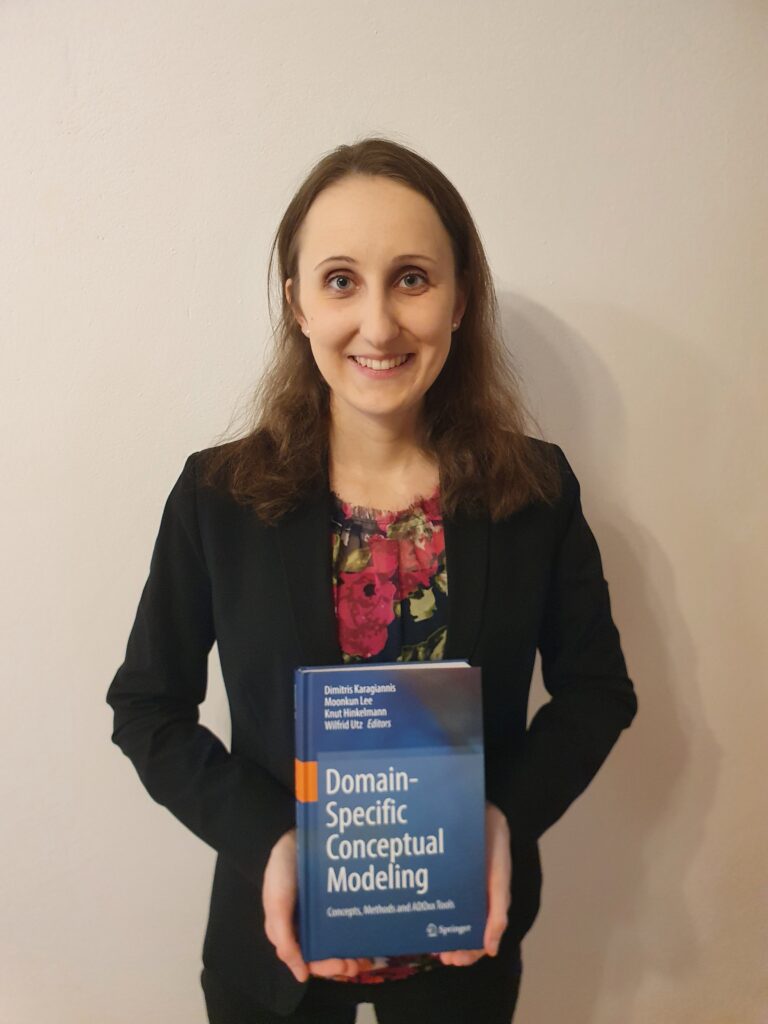
Anna is the author of the chapter “Model-Based Guide Toward Digitization in Digital Business Ecosystem“
Congratulations to our project colleague Anna Sumereder from BOC Group who has recently published two scientific publications about the role of modelling in digitalization processes in enterprises. In both publications Anna reflects her experience as a technical co-mentor of the Change2Twin pilot experiment with Graphenstone, a Spanish maker of ecologic paints. The goal of this experiment was to create a digital twin for the Graphenstone plant to bring more transparency into the production in terms of smart labeling. The digital twin was created based on process and data models and a prototype was tested in the OMiLAB Innovation Corner at BOC Vienna.
Based on this experience (the experiment lasted from September 2020 until March 2022) Anna has authored a chapter for the book “Domain-Specific Conceptual Modeling” published by Springer. The title of the chapter is “Model-Based Guide Toward Digitization in Digital Business Ecosystem” and it proposes a modelling method which enables to guide key aspects for the digitalization process. The text also covers the physical OMiLAB Innovation Corner experiment which helps to understand the domain problem and facilitates the selection of an appropriate digitization unit, taking into account potential physical issues and requirements from the business perspective. The co-author of this chapter is Change2Twin coordinator Tor Dokken from SINTEF Digital.
At the same time as the above book was published, the journal Computers in Industry published Anna´s article “Model-based data integration along the product & service life cycle supported by digital twinning”. This article was written together with Robert Woitsch and Damiano Falcioni, both from BOC and also active partners in Change2Twin and the Graphenstone experiment. In this article the authors show how digital technologies may result in the adaptation of products, service life cycles and even business models.
As a researcher and PhD candidate, Anna is deeply involved in the topic of model-based digitalization, so we asked her, what were the main lessons learned that she takes from accompanying the Graphenstone experiment:
“Physical experiments and digital twins can be used among other aspects for integration purposes such as integrating data along the product and service life cycle, where also real-time monitoring and simulation can improve the lifecycle management. Digital twins (of production processes) allow the integration and consideration of holistic perspectives ranging from business to technical viewpoints. Therefore, also companies with low digitization and servitization levels can apply digital twins of organisations and processes.”
Anna Sumereder, BOC
She adds: “Many thanks to Eugenio Quintero from CT-Ingenieros, who has been the main contact point with Graphenstone, for all his efforts and cooperation. Following and extending the Graphenstone pilot experiment in Change2Twin, further physical experiment developments are planned for the next round of pilot mentoring.”
If you want to know more, then meet Anna at the ECCOMAS 2022 minisymposium in summer or contact her via anna.sumereder(at)boc-group.com or via LinkedIn.
Further reading:
Sumereder A., and Dokken T. (2022). Model-Based Guide Toward Digitization in Digital Business Ecosystems. In: Karagiannis D., Lee M., Hinkelmann K., Utz W. (eds) Domain-Specific Conceptual Modeling. Springer, Cham. https://link.springer.com/chapter/10.1007/978-3-030-93547-4_18
Woitsch R., Sumereder A., and Falcioni, D. (2022). Model-based data integration along the product & service life cycle supported by digital twinning. Computers in Industry, Volume 140, 103648. ISSN 0166-3615. Accessible for free till 27 May 2022 via https://authors.elsevier.com/c/1et8JbquFR59A